D asystole b - Study guides, Class notes & Summaries
Looking for the best study guides, study notes and summaries about D asystole b? On this page you'll find 1344 study documents about D asystole b.
Page 3 out of 1.344 results
Sort by
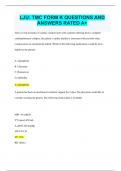
-
LJU: TMC FORM K QUESTIONS AND ANSWERS RATED A+
- Exam (elaborations) • 68 pages • 2024
- Available in package deal
-
- $11.99
- + learn more
LJU: TMC FORM K QUESTIONS AND ANSWERS RATED A+ After several moments of cardiac compressions with a patient suffering from a complete cardiopulmonary collapse, the patient's cardiac rhythm is consistent with asystole when compressions are momentarily halted. Which of the following medications would be most helpful to the patient: A. epinephrine B. Lidocaine C. Romazicon D. Quinidine A. epinephrine A patient has been on mechanical ventilator support for 5 days. The physician wou...
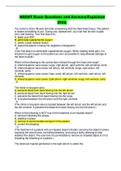
-
NREMT® EMR Exam Prep / NREMT Exam Questions and Answers/Explained 2022.
- Exam (elaborations) • 28 pages • 2022
- Available in package deal
-
- $10.99
- 15x sold
- + learn more
NREMT Exam Questions and Answers/Explained 2022. You arrive to find a 48 year old male complaining that his chest feels heavy. The patient is awake and talking to you. During your assessment, you note that his skin is pale, cool, and clammy. Your first step is to: A. apply your AED B. administer supplemental oxygen C. obtain a past medical history D. assist the patient in taking his neighbor's nitroglycerin Which of the following is the correct flow of blood through the heart and lun...

-
CEN PRACTICE TEST Q&A
- Exam (elaborations) • 16 pages • 2024
-
- $12.49
- + learn more
Preload refers to: a. The volume of blood entering the left side of the heart b. The volume of blood entering the right side of the heart c. The pressure in the venous system that the heart must overcome to pump the blood d. The pressure in the arterial system that the heart must overcome to pump the blood - Answer-b. The volume of blood entering the right side of the heart Preload is the volume of blood that enters the right side of the heart. This volume stretches the fibers in the he...
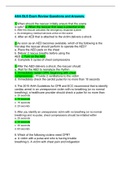
-
AHA BLS Exam Review Questions and Answers. 2023 Update
- Exam (elaborations) • 11 pages • 2023
-
- $13.49
- 1x sold
- + learn more
AHA BLS Exam Review Questions and Answers. 2023 Update. 1. When should the rescuer initially ensure that the scene is safe? a. When the rescuer first sees a potential victim b. After the rescuer activates the emergency response system c. As emergency medical services arrive on the scene d. After an AED that is attached to the victim delivers a shock 2. As soon as an AED becomes available, which of the following is the first step the rescuer should perform to operate the AED? a. Place the ...

-
AHA BLS Exam (Latest 2024/ 2025 Update) Questions and Verified Answers| 100% Correct| Grade A
- Exam (elaborations) • 18 pages • 2024
- Available in package deal
-
- $10.99
- + learn more
AHA BLS Exam (Latest 2024/ 2025 Update) Questions and Verified Answers| 100% Correct| Grade A Q: Why is it important to compress to the appropriate depth during CPR? a. Adequate depth of compression is needed to create blood flow during compressions b. Adequate depth of compression is needed to create air flow into the lungs and adequate oxygenation c. Adequate depth of compression is needed to prolong asystole d. Adequate depth of compression is needed to stimulate spontaneous respiratio...
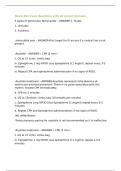
-
Sharp ESO Exam Questions with all correct Answers
- Exam (elaborations) • 25 pages • 2024
-
- $11.49
- + learn more
Sharp ESO Exam Questions with all correct Answers 3 types of Ventricular Tachycardia: - ANSWER-1. Stable 2. Unstable 3. Pulseless .antecubital vein – ANSWER-First target for IV access if a central line is not present .Asystole – ANSWER-i. CPR (2 min.) ii. O2 at 15 L/min. Ambu bag iii. Epinephrine 1 mg IVP/IO (use epinephrine 0.1 mg/ml), repeat every 3-5 minutes iv. Repeat CPR and epinephrine administration if no signs of ROSC .Asystole treatment – ANSWER-Asystole represents ...
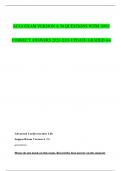
-
ACLS Exam Version A 2023/2024- 50 Questions and Answers
- Exam (elaborations) • 32 pages • 2023
-
- $22.99
- + learn more
You find an unresponsive patient who is not breathing. After activating the emergency response system, you determine that there is no pulse. What is your next action? A. Open the airway with a head tilt–chin lift. B. Administer epinephrine at a dose of 1 mg/kg. C. Deliver 2 rescue breaths each over 1 second. D. Start chest compressions at a rate of at least 100/min. 2. You are evaluating a 58-year-old man with chest pain. The blood pressure is 92/50 mm Hg, the heart rate is 92/min, the...
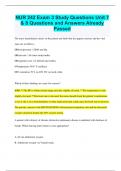
-
NUR 242 Exam 3 Study Questions Unit 7 & 8 Questions and Answers Already Passed
- Exam (elaborations) • 31 pages • 2024
-
- $10.49
- + learn more
NUR 242 Exam 3 Study Questions Unit 7 & 8 Questions and Answers Already Passed The nurse immediately checks on the patient and finds that she appears anxious and her vital signs are as follows: ØBlood pressure: 128/84 mm Hg ØHeart rate: 114 (sinus tachycardia) ØRespiratory rate: 24, labored and restless ØTemperature: 99.4° F (axillary) ØO2 saturation: 91% on 40% O2 via trach collar Which of these findings are cause for concern? ANS: **The BP is within normal range and only...
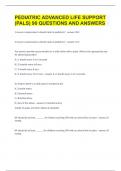
-
PEDIATRIC ADVANCED LIFE SUPPORT (PALS) |90 QUESTIONS AND ANSWERS.
- Exam (elaborations) • 21 pages • 2023
- Available in package deal
-
- $14.49
- + learn more
1 rescuer compression to breath ratio in pediatrics? 30:2 2 rescuer compression to breath ratio in pediatrics? 15:2 You need to provide rescue breaths to a child victim with a pulse. What is the appropriate rate for delivering breaths? A.) 1 breath every 3 to 5 seconds B.) 2 breaths every 6-8 secs C.) 1 breath every 6 secs D.) 1 breath every 10-12 secs A.) 1 breath every 3 to 5 seconds An infant's (birth-1 yr old) pulse is checked at the A.) Carotid artery B.) Femo...
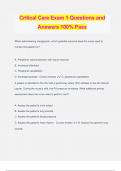
-
Critical Care Exam 1 Questions and Answers 100% Pass
- Exam (elaborations) • 42 pages • 2024
- Available in package deal
-
- $13.49
- + learn more
Critical Care Exam 1 Questions and Answers 100% Pass When administering nitroglycerin, which possible outcome does the nurse need to monitor the patient for? A. Peripheral vasoconstriction with tissue necrosis B. Increased afterload C. Peripheral vasodilation D. Increased preload - Correct Answer ️️ -C. peripheral vasodilation A patient is admitted to the ICU with a pulmonary artery (PA) catheter in the left internal jugular. During the nurse's shift, the PA pressure increases. Wha...

That summary you just bought made someone very happy. Also get paid weekly? Sell your study resources on Stuvia! Discover all about earning on Stuvia


